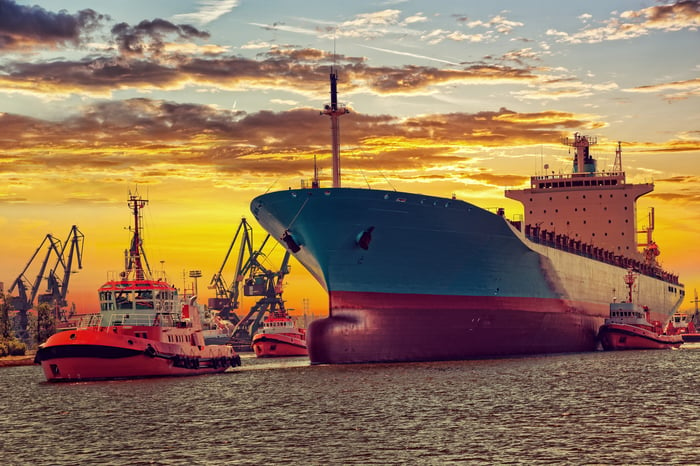DryShips (DRYS) spent much of last year jettisoning vessels from its fleet to raise cash and shore up its balance sheet. Overall, the company unloaded 10 dry bulk ships and its stake in an offshore drilling company. By doing so, the company put its finances back on solid ground by the end of the year, which positioned it to start rebuilding its fleet with new vessels so it could grow off that new base.
That is just what it has done since the beginning of the year, going on a buying binge by purchasing 17 ships that expanded its dry bulk carrier business and diversified its operations into oil tankers and gas carriers. These ships have the capacity to deliver significant earnings growth over the coming year if everything goes according to plan.

Image source: Getty Images.
Patching up the leak
One of the reasons DryShips needed to sell off so many ships last year is that it lost a boatload of money due to sinking shipping rates. Overall, it reported a negative $42.3 million in adjusted EBITDA last year, which was an abrupt reversal from the prior year, when it generated $469.1 million of adjusted EBITDA. The company would go on to tally another loss in the first quarter, reporting a negative $7.4 million in adjusted EBITDA after spending $2 for every $1 it collected in revenue.
That said, DryShips expects that the 17 ships it has bought so far this year will eventually plug the gaping hole in its cash flow statement. Several of the ships it acquired either came with (or DryShips subsequently signed) time charters that will lock in a predictable cash flow stream. For example, the company has purchased four gas carriers this year that all came with long-term time charters that represent up to $392 million of future revenue potential.

Image source: Getty Images.
Adding it all up
When adding the cash flow from these contracts with what it anticipates its unchartered vessels can earn on the spot market, DryShips estimates that its rebuilt fleet can produce $77 million of EBITDA on an annual basis. That would mark a huge shift from last year's loss.
That said, this earnings growth won't come all at once. According to comments by CEO George Economou in early May, the company expects that "our earnings and cash flows will build up during the second half of 2017." Driving that view is the fact that DryShips has been slowing taking delivery of its recent purchases over the past several months. As of its latest update, the company had taken control of 11 vessels and should take delivery of the other six later this year. Because of those staggered deliveries, DryShips' earnings should steadily grow over the next several quarters if shipping rates cooperate.
Meanwhile, the company continues to raise cash, which gives it the financial flexibility to make additional vessel acquisitions. In late May, for example, DryShips announced that it received a firm commitment for a senior secured credit facility of up to $150 million using its four gas carriers as collateral. That left the company with another 32 vessels that currently are unencumbered, which it estimates could allow it to raise up to $250 million in additional debt funding if it leverages those vessels at 50% of their market value. If DryShips is successful in raising that financing, it could make additional accretive vessel acquisitions later this year without needing to make another highly dilutive equity offering, which have been a massive weight on the stock this year.
Investor takeaway
After gutting its fleet last year, Dryships has quickly rebuilt it in 2017, which due to the makeup of its fleet should drive steady earnings and cash flow growth in the second half of the year. Meanwhile, with the ability to start securing its ships with debt financing, it should have the capital to buy more vessels and further increase its earnings capacity.
That said, while DryShips' growth days appear to be about to begin, investors have paid a high price for this growth via dilution. The company has issued hundreds of millions of dollars in stock over the past several months so it could buy all these ships. As a result, the company has flooded the market with new shares, which has put significant pressure on the stock price. Because of this, DryShips' stock might continue heading lower while the market digests the boatload of new shares it issued this year.





